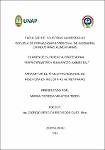Refrigerantes y su impacto ambiental
Abstract
Los refrigerantes son fluidos vitales en cualquier sistema de refrigeración mecánica, climatización de espacios y conservación de alimentos. Cualquier substancia que cambie de líquido a vapor y viceversa, puede funcionar como refrigerante, dependiendo del rango de presiones y temperaturas a la que se realizan estos cambios, tendrá una aplicación comercialmente útil. Sin embargo, algunos de los elementos del proceso son perjudiciales para nuestro planeta. Existe una gran cantidad de fluidos refrigerantes fácilmente licuables; sin embargo, sólo unos pocos se utilizan actualmente. Algunos se usaron mucho en el pasado, pero se eliminaron al ingresar otros con ciertas ventajas y características que los hacen más apropiados. Recientemente, se decidió suspender algunos de esos refrigerantes antes del año 2000, como R-11, R-12, R-113, R-115, etc.; debido al deterioro que causan a la capa de ozono en la estratósfera. En cambio, se usarán otros refrigerantes como R-123, el R-134a y algunas mezclas ternarias. Los grandes fabricantes de refrigerantes, continúan trabajando en el desarrollo de nuevos productos. Los refrigerantes del tipo HCFC, (sustitutos de los CFC) son menos dañinos para la capa de ozono, con un potencial de agotamiento de la capa de ozono de 0.05 y tienen una fecha más distante para su cese de producción y uso. Otro impacto ambiental de los refrigerantes CFC y HCFC es el aumento del efecto invernadero.
El potencial de agotamiento del ozono es un número que se refiere a la cantidad de destrucción de ozono estratosférico causada por una sustancia del refrigerante. Es la razón entre el impacto sobre el ozono causado por una sustancia determinada y el impacto causado por una masa similar de CFC-11 (el potencial de agotamiento del CFC-11 se define como grado 1). Refrigerants are vital fluids in any mechanical refrigeration system, space air conditioning and food preservation. Any substance that changes from liquid to vapor and vice versa, can function as a refrigerant, depending on the range of pressures and temperatures at which these changes are made, it will have a commercially useful application. However, some of the elements of the process are harmful to our planet. There is a large amount of easily liquefiable refrigerant fluids; However, only a few are currently used. Some were used a lot in the past, but were eliminated by entering others with certain advantages and features that make them more appropriate. Recently, it was decided to suspend some of these refrigerants before the year 2000, such as R-11, R-12, R-113, R-115, etc.; due to the deterioration they cause to the ozone layer in the stratosphere. Instead, other refrigerants such as R-123, R-134a and some ternary mixtures will be used. Large refrigerant manufacturers continue to work on the development of new products. The refrigerants of the HCFC type, (substitutes for CFCs) are less harmful to the ozone layer, with an ozone depletion potential of 0.05 and have a more distant date for their cessation of production and use. Another environmental impact of CFC and HCFC refrigerants is the increase in the greenhouse effect. The ozone depletion potential is a number that refers to the amount of stratospheric ozone destruction caused by a substance in the refrigerant. It is the reason between the impact on ozone caused by a given substance and the impact caused by a similar mass of CFC-11 (the depletion potential of CFC-11 is defined as grade 1).
Collections
The following license files are associated with this item:


